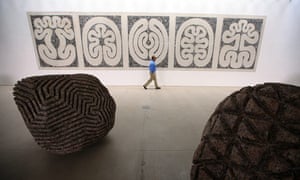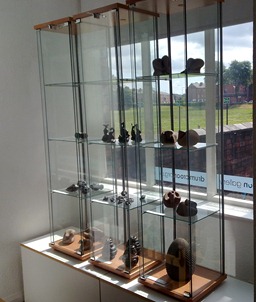According to his website he has
“….. always been informed and inspired by the study of organic form and its subjective impact on our emotions.”
and many of his works certainly are influenced by nature, particularly plants and seeds.
"geometry is the theme on which nature plays her infinite variations, fundamental mathematical principle become a kind of pattern book from which nature constructs the most complex and sophisticated structures."
"I want my forms to function as a psychological investigation, which hopefully will strike a chord of recognition in the viewer. I’m an absolute rationalist. I don’t believe in a collective unconscious in the strictly Jungian sense, but it would be pretty remarkable if certain forms didn’t have a resonance since we share an evolutionary history. Noam Chomsky pointed out that while babies born in different cultures learn different languages, we all share an innate propensity for language, and the same basic grammatical structures seem to be hardwired into all of us. Perhaps the same argument could be applied to our appreciation of visual art."
Secret Life VI
Peter Randall-Page is an extraordinary British sculptor and visual artist whose connection to nature began in the Sussex countryside. For Randall-Page, organic forms are places to begin, shapes that push the artist to explore his own response to them.
Randall-Page does not simply render natural forms. Like a poet plunging through metaphor toward meaning, he discovers ways to shape the form's felt energies. Natural forms are ambiguous; they are all elaborations of Earth’s great themes: shared origins, interdependence, obedience to gravity and the circle.
Many commentators have noted the ambiguity of Randall-Page's sculpture, its metamorphic qualities. His sculptures refuse to be one thing or another. Echoing life, they continually shift phase, defying categories such as animal, vegetable and mineral.
His deeply moving sculptures are sometimes calm and contemplative, recalling a variety of organic forms found in nature – fossils, fruit, pods and shells. At other times, evolving from the forms of knots and coils, they are immensely powerful and expressive, full of virility and adventure. Their immaculate surface, detail and curvaceous rhythm evoke life forces simply, directly and with great beauty.
Fruits of Mythic Trees, Kilkenny limestone, 1992
|
“I wanted to make a sculptural equivalent of an emotional state—the dark, knotted centre, the consciousness of being alone.”
A Place of One’s Own 1994;Etching on paper
| In His Own Words |
|---|
Excerpts from interviews with Paul Nesbitt and Brian McAvera, and quotations from Sculpture and Drawings 1977-1992:
I grew up in the country and always found the natural world deeply engaging. Later, through my work, I became particularly interested in seeds and fruit. They embody the potential for growth and can be sensual, even erotic. They detach from the parent plant, becoming separate entities full of energy to develop into full-blown plants. I have also always been fascinated by the relationship between outer appearance and internal structure, between surface and volume.
One could speak of different species as each having its own song, tone or note. There's a sense in which they are all akin, each playing its own particular tune. I would like my work to have something of this same quality. For me, when a sculpture is ‘right’, when the form has coherence and the object seems at one with itself, it has an almost audible hum, each part having a harmonious relationship with the whole.
I think we have a much closer connection with other living things, both flora and fauna, than we realize. We are all part of the same biological system and my desire is not only to know this intellectually but to feel it in my bones. The blurring of boundaries between zoology and botany in my work is, in some ways, an expression of this desire to lose a sense of alienation from the rest of the natural world and to experience the reality of its intimacy...
It is obviously a deliberate choice on my part to carve --I have just found for me that carving is an extremely good way of dealing with subtlety, with striking a chord and achieving a kind of resonance through a subtle control of form.
My work is both a celebration of the natural world and an exploration of its expressive potential - a subjective celebration of the underlying energy behind everything that lives and grows.
I am not interested in illustrating ideas conceived in words; I am interested in working from direct physical experience. The process of carving, rather than stone itself, is important to me. Carving, like drawing and modeling, is conducive to a meditative process where decision, action, and appraisal become fused in a fluid working dialogue. In short, the act of carving itself helps me to access my imagination.
Carving and drawing are good ways of tapping into subconscious feelings and images, through an unself-conscious dialogue in the process itself. The process engenders contemplation. It’s physical and repetitive, keeping the body busy and liberating the imagination at a deeper level.
I want my forms to function as a psychological investigation, which hopefully will strike a chord of recognition in the viewer. …It would be pretty remarkable if certain forms didn’t have a resonance since we share an evolutionary history.
Much of my work is derived from botanical and other natural things, but …there is quite a strong strain running through the work which is pure invention.
I’m trying to make certain forbidden aspects of privacy beautiful, closer to rightness. I’m led by that. Reconciliation is one of the important functions of art.
I’ve always had a tremendous feel for sensuality, for form and touching things and volume. I spent a lot of time on my own, looking closer and closer and closer at a [slate] shingle, for instance, and suddenly seeing the geometry of a shell, like another world poking through. My dad made his living as a model-maker, so the idea of making things was there. I went to the British Museum and the Ethnographic Museum as a child. The Egyptian room in the British Museum, the intensity of the objects, moved me. These people made the same images over thousands of years, a cultural distillation like natural selection. Everything non-vital was stripped away. That hit me like a thump in the chest.
I’ve never been interested in making sculpture which implies frozen movement or ‘a moment in time’. I’d like to make things which are at rest, where the energy is internalised. Perhaps plant forms, particularly fruit and seeds, lend themselves to this sense of implicit life. They may have the feeling that they could burst into life but from the inside rather than in an obviously animated way.
You have to work at the gaps between different images; it’s not quite this and it’s not quite that and hopefully it can evoke a feeling rather than stopping at the identification and naming of the object itself.
My drawing has always run parallel to making sculpture. Sometimes the drawings are preparatory to sculpture, sometimes they stand on their own. I did a set of drawings a few years ago called ‘Fruiting Bodies’ which were of an architectural scale. I drew them with charcoal attached to a long pole, and they were very physical to make.
I like drawing from the shoulder rather than wrist. For me the problem with working from the wrist is that the brain locks into the mode of writing, of putting down information in a coded form; that's why I use charcoal such a lot; you tend not to hold it in the same way as a pencil.
Many of the drawings have a lot of black in them; it's a bit like carving, starting with a block and chipping away the bits you don’t want. I approach drawing in a similar way, starting with a white piece of paper and blacking in all that I don’t want to remain.
My drawing has always run parallel to making sculpture. Sometimes the drawings are preparatory to sculpture, sometimes they stand on their own. I did a set of drawings a few years ago called ‘Fruiting Bodies’ which were of an architectural scale. I drew them with charcoal attached to a long pole, and they were very physical to make.
I like drawing from the shoulder rather than wrist. For me the problem with working from the wrist is that the brain locks into the mode of writing, of putting down information in a coded form; that's why I use charcoal such a lot; you tend not to hold it in the same way as a pencil.
Many of the drawings have a lot of black in them; it's a bit like carving, starting with a block and chipping away the bits you don’t want. I approach drawing in a similar way, starting with a white piece of paper and blacking in all that I don’t want to remain.
Womb Tomb
Womb Tomb 2000 granite 230 (h) x 335 (l) 270 (w)cm 213 (d) x 270 (l) x 230 (w) cm Enabled by Sculpture at Goodwood, 'Womb Tomb' was cut from an enormous granite boulder in Southern Germany. The two halves have been hollowed out and carved into concentric rib like rings on their internal surfaces. One half sits horizontally like a cave the other is sunk vertically into the ground like a well.
Speaking about his sculpture,he says: "..stone in itself evokes an enormous sense of time which is beyond our comprehension...it puts you in you place and make you feel humble to the work with the material. As you carve the stone, one is in a sense uncovering something which has not been covered for millions and millions of years.." Talking about the material he uses, he says: " .. there is a kind of life even in the dead materials..the challenge is to try to imply a sense of life within it.." (https://vimeo.com/3803009)

These small metal castings are miniature versions of a larger sculpture and are possibly maquettes.

Links:


No comments:
Post a Comment